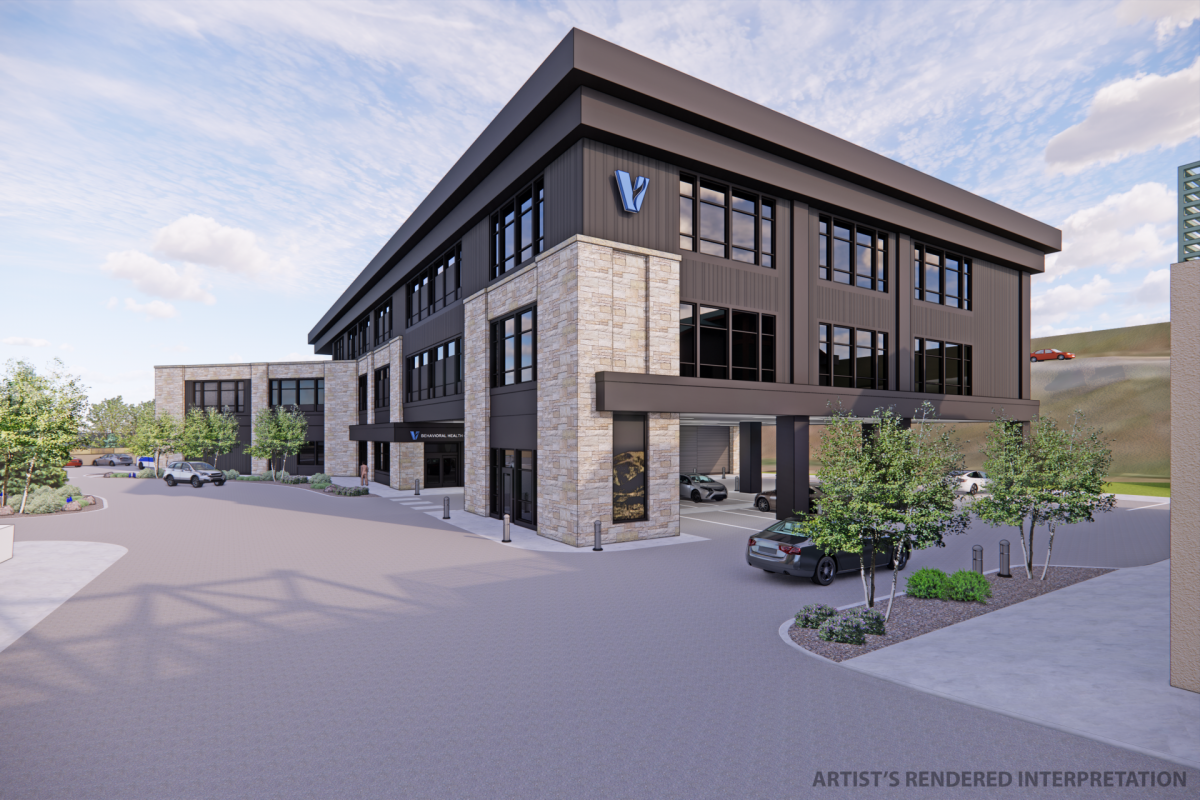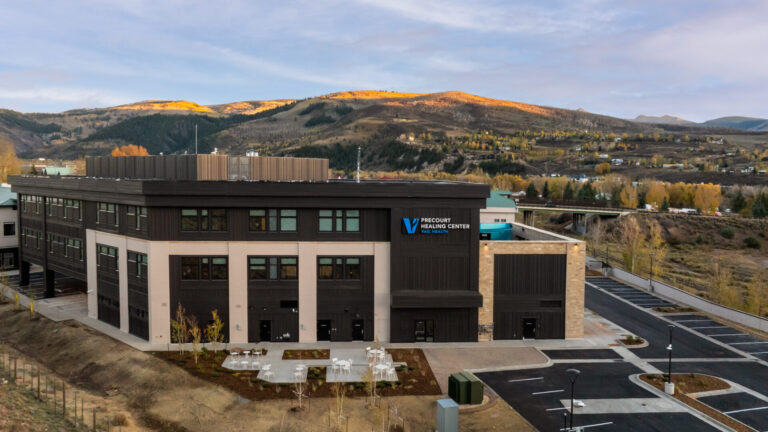Tackling the Paradise Paradox: Vail Health Breaks Ground on New Inpatient Behavioral Health Facility in Edwards

On Thursday, Sept. 1, the Vail Health Foundation hosted a groundbreaking ceremony for the Precourt Healing Center, ushering in a new era for behavioral health services in Eagle County.
“What’s happening today in this valley, I can honestly say I do not believe it’s happening anywhere else in the United States and for that matter, potentially anywhere else in the world,” said Chris Lindley, the executive director of Eagle Valley Behavioral Health and chief population health officer at Vail Health. “Our vision here in this valley is to one day spend as much money, time and effort on our behavioral health as we do our physical health. I believe today we are doing that. In fact, I am certain we are doing that in this valley.”
The new 50,000-square-foot inpatient behavioral health facility will be located at Vail Health’s Edwards Community Health Campus and will provide 28 beds for short-term stays and treatment to the valley.
“Eagle County residents have nowhere to go. I get a call a week from somebody who says they’re trying to find a place to go to get a break from life and to get safe and there’s nowhere to go,” said Amanda Precourt, the facility’s namesake and a member of both the Eagle Valley Behavioral Health board and Vail Health Foundation board. “I believe we’re doubling the number of beds on the Western Slope, but right now, in Eagle County and Pitkin County, there are no psychiatric beds. So we’re building something that doesn’t exist.”
In addition to these 28 beds — 14 of which will be for adolescents and 14 of which will be for adults — the three-story healing center will provide:
- 24-hour behavioral health care serving adults and adolescents in crisis (ages 12 and older);
- Behavioral health services in English and Spanish;
- Structured behavioral health services that prioritize crisis resolution, safety and stabilization;
- Family support, intervention and engagement;
- Comprehensive case management across the community continuum of care; and
- Collaborative community-based discharge planning.
“The Precourt Healing Center is going to catch that group that is being totally dropped right now and have nowhere to land to get healthy and figure out where they need to go for the next step of their healing,” Precourt said.
Construction on the new center is expected to start in September, with the facility set to be complete by Spring 2025.
“There’s not enough inpatient behavioral health beds just about anywhere, let alone up in the mountain communities — so it’s a supply and demand issue,” said Will Cook, the president and CEO of Vail Health, in an interview with the Vail Daily on Thursday. “We absolutely want to provide care to our locals and in our mountain communities and this is a really important piece of being able to do that. This lets locals get the advanced care closer to home that they deserve so they don’t have to worry about traveling, family members not being there.”
Building a Continuum of Care
The inception of this facility can be traced back to five years ago with a “bold idea” from the Eagle County commissioners to raise a tax on marijuana to fund behavioral health services in the county, Lindley said on Thursday.
“At that time in this community, there was essentially $0 going to behavioral health,” he said.
From there, Lindley detailed the steps taken by community leaders — including nonprofits, law enforcement leaders, leaders from the district and local hospitals as well as local governments — to identify how the county could transform behavioral health in the valley.
The No. 1 priority and initiative identified, he said, was “the building of the behavioral health facility in this valley, so that one day our community would never have to leave this valley to get the needed therapeutic care they need to be healthy and to stay healthy in this valley.”
“Today, we’re accomplishing that No. 1 initiative, which is breaking ground on that facility moving forward,” Lindley added.
Cook addressed the need for the facility Thursday, identifying the ways that community members have been failed in the past.
“It’s not OK that people would have to travel to Denver or Grand Junction for care,” he said. “It’s not OK that we didn’t have enough providers to provide people the care they need on a regular basis, such that the problem would fester to a point in which you ended up in an emergency department and ultimately sat there maybe for three days waiting to get transferred somewhere. Then you would get transferred, and inevitably you come back here and you’d have no one to sort of do a warm hand-off with and take over that care. And so what would happen? We would rinse and repeat the process.”
“This is not only incredibly poor care, it’s also incredibly expensive,” he added. “And so the time is now to change that.”
While the need for the facility highlights the gap in services, the community has still made immense strides to address the growing need for mental and behavioral health services in the past three and a half years, Lindley said.
According to Lindley, in these past three years — with the inception of Eagle Valley Behavioral Health as well as with the partnership between it and 20 local nonprofits — the number of behavioral health providers has doubled.
“We now have 60 licensed providers working in this valley,” Lindley said, adding that among them are the two psychiatrists (including the only adolescent psychiatrist on the Western Slope), two psychiatric nurse practitioners and multiple behavioral therapists.
“But most importantly, all those providers accept insurance; all those providers accept Medicaid; all those providers accept Medicare; and all those providers accept Olivia’s Fund, which is our scholarship program,” he said.
Through this, Lindley said that more community members than ever are getting the care and support they need.
Overall, the construction of this new facility as well as the strides made by Eagle Valley Behavioral Health and other local nonprofits addressing mental and behavioral health, all serve to address the behavioral health crisis and the whole person approach to health that Vail Health is striving to achieve.
“We’re going to get back to living out our mission of elevating health across the mountain communities we serve,” Cook said in his speech. “We’re going to get back to making sure that this place is not just a wonderful place to live, but to visit and to thrive and to not have to worry about whether or not you can get the care you need. And that’s not just orthopedic care or oncologic care. It’s also behavioral health.”
Earlier this year, Eagle Valley Behavioral Health received a Behavioral Health Entity License from the state of Colorado. It’s the last step it needed to become a designated Community Mental Health Center in Colorado and unlock the funding that comes with this designation. Eagle Valley Behavioral Health was only the 17th organization to receive this designation in the state and the first since 1989.
“By applying for and receiving Community Mental Health Center Status, you first and foremost demonstrate that you have all the requisite services and can meet the standards that are needed to receive said designation,” Cook said. “That includes comprehensive outpatient services and doing some things like integrating primary care and schools and all the rest of it. But it also puts you in a position then, as a result of meeting those requirements, to receive funding from the state to position you to get resources to provide that care, whether or not its inpatient or outpatient.”
This designation, he added, not only creates a sustainable funding source but also sets the organization to treat the whole person through services as well as through partnerships.
“The beauty of this campus, the Edwards Community Health campus, is we’ve got the Community Market, which helps people who may be struggling for food, and its like Maslow’s hierarchy of needs: if you don’t have food and shelter, you can’t be thinking about how you’re managing your health,” Cook said. “To have, here, the United Way; to have here, My Future Pathways for programs for kids; to have here, case management, which helps people understand not just the physical health issues and their behavioral health issues but what some of those social determinants of care are.”
Having the designation of community health center, he added, “will help bring more resources, not just to us, but to a lot of the other organizations in this valley that support the people that live here.”
According to Sally Welsh, Vail Health’s director of public relations, Eagle Valley Behavioral Health has already begun to receive this funding, primarily for crisis response. This includes $300,000 during the last fiscal year and $600,000 this fiscal year.
The campus will also be home to the Wiegers Mental Health Clinic, which will offer intensive outpatient behavioral health programming, group therapy, specialty psychiatric services, and comprehensive psychological evaluations. The clinic is named in recognition of a donation from the George and Betsy Wiegers Family Foundation and is scheduled to open in early 2023.
Over the past three years, this progress — as well as the progress to come with the new facility — represents a shift both in the recognition of the need for behavioral health support and services and in the stigmas around mental and behavioral health.
This stigma has been broken down by creating conversations around behavioral health, adding services and people like Precourt, who as Cook put it in his speech Thursday served as a “catalyst for breaking the stigma.”
“(Amanda), despite the fears and the emotions associated with speaking about her own experience, stood up and said enough is enough and we’re going to do something about it,” Cook said. “She shared vulnerabilities and our own experiences and in my mind is a living example of what it takes to overcome a lot of these challenges with behavioral health.”
Breaking Stigma and Building Hope
Precourt spoke on Thursday about her experience with mental health, which started with a diagnosis of generalized anxiety and depression when she was a junior in college at Princeton. From her diagnosis through her early adult life, panic attacks and bouts of depression were a normal occurrence, she said. However, when she was 38 years old, Precourt said she started having debilitating insomnia and panic attacks daily.
“For the first time in my life, I was entirely unable to function,” she said. “In a moment of desperation and exhaustion, I tried to throw myself out of a moving car while in the passenger’s seat on I-70. I thought I could no longer survive another day. I lost all hope.”
At the time, “the support system for behavioral health in Vail and the state of Colorado at large was dismal, to say the least,” Precourt said.
Following her suicide attempt, Precourt was placed on a 72-hour hold at Vail Valley Medical Center, where she was held in a “tiny auxiliary storage room in the ER surrounded by medical supplies with only one chair for more than 13 hours, with two armed policemen outside my door,” she said.
Ultimately, Precourt said she was transported to a psychiatric hospital and then later spent 15 weeks in a residential treatment facility “to get my mind and body medically stabilized.”
Even with her experience, Precourt called herself “one of the lucky few who survived a suicide attempt” and didn’t end up in a jail cell, which is often the outcome for individuals who have “made a suicide attempt or suffered from addiction in our community,” she said.
For many, “there was no diagnosis, no stabilization, and no dignity in the process,” she said. “Sadly, in most cases, the individual would return home only to go back to their addictive lifestyle or to make another suicide attempt, usually within days. Many didn’t survive.”
Also, at the time, Precourt said that the stigmas around mental and behavioral health were so great that she kept her experiences to herself.
“At the time, we agreed as a family that I would not speak to anyone about where I had been. I would not speak about my depression and my anxiety. There would be no public acknowledgment of my suicide attempt. We agreed it was better to keep it silent because at that time no one understood. At that time, talking openly about suffering with a mental health issue caused even more isolation for the patient and further misunderstanding in society. I stayed silent,” Precourt said. “Now it is time to speak.”
However, over time, Precourt said she’s seen this begin to shift.
“Now, I could cry. Now, it’s a badge I wear with pride because I know that everyone struggles with it and now we’re talking about it and that’s amazing,” she said in an interview with the Daily. “It brings me to tears because I didn’t know that this much could happen in such a short period of time, and so much profound shift could happen.”
And, moving forward, the Precourt Healing Center is the next step in addressing the mental health crisis and continuing the process of destigmatizing behavioral health, she said.
“The new facility will change the face of how we deal with acute behavioral issues in our community,” she said. “In three and a half short years, Vail Health And Eagle Valley Behavioral Health have already done so much to not only destigmatize behavioral health issues but to also deliver state-of-the-art care and programming to all who need it.”


